

Vegetable Garden Plans layout diagram plant list.
Easy Edible Landscape: Add a Beautiful Food Garden to Your Yard in Just 14 Days. Current students: click here to share your garden!
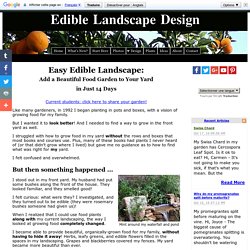
Like many gardeners, in 1992 I began planting in pots and boxes, with a vision of growing food for my family. But I wanted it to look better! And I needed to find a way to grow in the front yard as well. I struggled with how to grow food in my yard without the rows and boxes that most books and courses use. Plus, many of these books had plants I never heard of (or that didn't grow where I lived) but gave me no guidance as to how to find what was right for my yard. I felt confused and overwhelmed. But then something happened ... Mint around my waterfall and pond I stood out in my front yard. I felt curious: what were they? When I realized that I could use food plants along with my current landscaping, the way I looked at growing food completely changed. Asheville NC - Edible Yard & Garden. Broccoli. By Avis Licht Frost comes in different forms, not all are bad for the garden Some plants actually like a bit of frost.
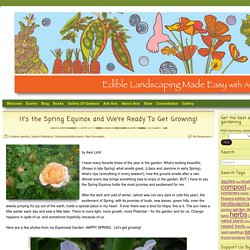
Knowing what to plant for the winter garden will help you be successful. And all frost is not created equal. A little frost on the plants, like the strawberries in the picture above, doesn’t hurt many plants. Here’s what you can do if you live in a frosty neighborhood: 1. Frost doesn't harm chard if it doesn't go below 20 deg F. 2. 3. 4. Here’s what you shouldn’t do during frosty days: Eat Your Yard! Design an Edible Landscape - DiyProjects.Tips. Flowers grow and then they die, and you get little use out of them besides a pretty picture.
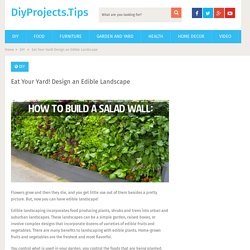
Fresh Herbs - Edible Landscaping. Edible Landscaping Plan for Beginners: Part One. Why plant just any plant in your landscaping when you can plant something edible and accomplish the same goal, whether it be shade, privacy, color, focus, erosion control, or design.
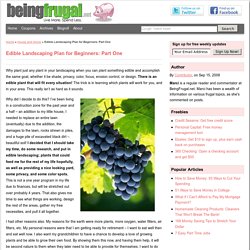
There is an edible plant that will fit every situation! The trick is in learning which plants will work for you, and in your area. This really isn’t as hard as it sounds. Why did I decide to do this? I’ve been living in a construction zone for the past year and a half – an addition to my little house, I needed to replace an entire lawn (eventually) due to the addition, the damages to the lawn, rocks strewn in piles, and a huge pile of excavated black dirt – beautiful soil! I had other reasons also. How to Plant a Perennial Food Garden – 20 Fruits & Veggies That Will Keep Coming Back Year After Year. Love gardening?
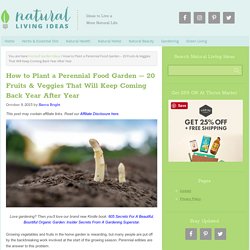
Then you’ll love our brand new Kindle book: 605 Secrets For A Beautiful, Bountiful Organic Garden: Insider Secrets From A Gardening Superstar. Growing vegetables and fruits in the home garden is rewarding, but many people are put off by the backbreaking work involved at the start of the growing season. Perennial edibles are the answer to this problem. Grow them among your regular veggies so that you will have something to look forward to even if you miss your spring or fall planting. Edible Landscaping, Rosalind Creasy, Vegetable Gardening, Fruits: Gardener's Supply. The low fence, and parallel gravel path — with its edging of dusty miller and purple violas — outline this bed and give it form.
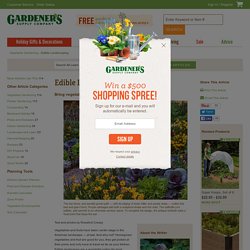
Purple cabbages add both a sculptural shape and rich color. The daffodils (not edible), add warmth to an otherwise somber scene. To complete the design, the antique birdbath adds a focal point that stops the eye About the Writer. Natural and Edible Landscaping. When the year 2000 approached it seemed backyards were getting smaller and more of us were living on the go.
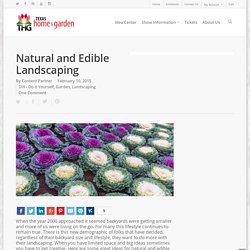
For many this lifestyle continues to remain true. There is this new demographic of folks that have decided, regardless of their backyard size and lifestyle, they want to do more with their landscaping. When you have limited space and big ideas sometimes you have to get creative. Edible landscaping zone 7. Edible landscaping zone 7. Perennialsolutions. February 12, 2013 User Admin Eric Toensmeier This post is to celebrate the release of my new Perennial Vegetable Gardening DVD!
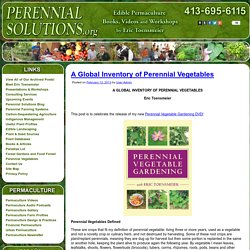
Perennial Vegetables Defined These are crops that fit my definition of perennial vegetable: living three or more years, used as a vegetable and not a novelty crop or culinary herb, and not destroyed by harvesting. Some of these root crops are plant/replant perennials, meaning they are dug up for harvest but then some portion is replanted in the same or another hole, keeping the plant alive to produce again the following year. Perennialsolutions. Untitled. There are berries (mulberry, blueberry, serviceberry, and chokeberry), fruits (apple and choke-cherry), nuts (filbert), and edible flowers (daylily) and tubers (sunchokes).
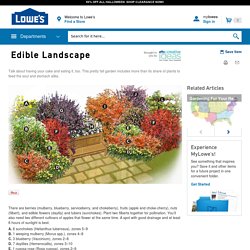
Plant two filberts together for pollination. You’ll also need two different cultivars of apples that flower at the same time. A spot with good drainage and at least 6 hours of sunlight is best. A. 6 sunchokes (Helianthus tuberosus), zones 5–9B. 1 weeping mulberry (Morus spp.), zones 4–8C. 3 blueberry (Vaccinium), zones 2–8D. 7 daylilies (Hemerocallis), zones 3–10E. 1 rugosa rose (Rosa rugosa), zones 2–9F. 2 chokeberry (Aronia melanocarpa), zones 3–8G. 1 purpleleaf plum (Prunus cerasifera), zones 5–9H. 1 rose of Sharon (Hibiscus syriacus), zones 5–9I. 1 serviceberry (Amelanchier x grandiflora), zones 3–7J. 1 choke-cherry (Prunus virginiana), zones 3–8K. 2 filbert (Corylus americana), zones 4–9L. 2 apple espalier (Malus spp.), zones 5–8.
Edible landscaping zone 7. Edible Shrubs for your Landscape (National Gardening Association) The American cranberry bush (Viburnum trilobum) features bright red berries in later summer, which people and birds love to eat.
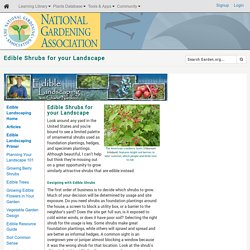
Look around any yard in the United States and you're bound to see a limited palette of ornamental shrubs used as foundation plantings, hedges, and specimen plantings. Although beautiful, I can't help but think they're missing out on a great opportunity to grow similarly attractive shrubs that are edible instead. Designing with Edible Shrubs The first order of business is to decide which shrubs to grow. Much of your decision will be determined by usage and site exposure. Rose hips are produced in abundance on rosa rugosa plants. Once you decide the function of the shrub and the likely location to plant it, then the fun begins.
While it's great to plant all edibles in your yard, there's no problem with mixing in a blueberry here or a currant there with other ornamental plantings. Here are some edible shrubs to grow based on their function in the landscape. Shrubs - Edible Landscaping. Plant Recommendations Zones 6-8 » Edible Landscaping with Rosalind Creasy. USDA Zones 6 through 8 cover areas of the country where the winter low temperatures seldom go below – 10 degrees F. The following are examples of edibles for your landscape in Zones 6 to 8: Annual Vegetables and Edible Flowers - cool season/ can withstand light frosts – all greens including: rainbow chards, mustards; cabbages, lettuces, kales etc.; flower bud vegetables: broccoli and cauliflower; root vegetables: carrots, beets, radishes, etc; plus peas, nasturtiums, calendulas, pansies, and winter wheat. Warm season/ no frost tolerance – beans, cucumbers, eggplants, melons, okra, peanuts, peppers, sweet potatoes, squash, slicing and cherry tomatoes.